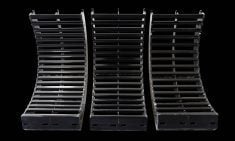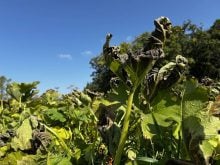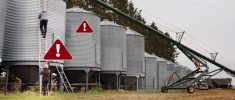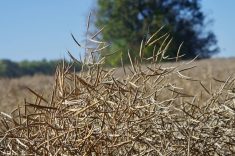Despite normal or slightly above average crop quality and yield, it was far from a typical year for most farmers.
For the province’s roll call of extension specialists, it wasn’t a typical year either.
The extreme weather swing this year compared to 2021 left grain farmers fighting late seeding, different staging for insects and disease pressure but yields were still average to slightly above.
Read Also

Seeding Indigenous agricultural prosperity
National Circle for Indigenous Agriculture and Food says Indigenous agricultural success needs strong relationships.
“Last fall at this time, we were getting a lot of soil testing done after the drought and we had very high nitrogen levels,” said John Heard, soil fertility specialist with Manitoba Agriculture.
Droughts are rarely a good thing, but with the price of fertilizer, that looked like good news.
“But what Mother Nature left with the drought, Mother Nature took a lot of that away with a very wet spring,” Heard added.
From the driest weather in decades, winter 2021 took a U-turn into a long and snowy season. In early spring 2022, things compounded. The province was hit by three Colorado lows in the space of a few weeks. That left fields saturated and washed away much of the nutrient producers might have hoped for after their fall soil test.
[RELATED] Manitoba Crop Report for October 25, 2022
In recent weeks, Heard says he has scouted 20 cornfields for nitrogen deficiencies.
“We always expect the leaves to fire or turn yellow or brown from the bottom up, and that’s quite normal. The plant stores nitrogen during green fill, and it moves some to the kernels, so we expect to see that yellowing,” Heard said.
But if the yellowing leaves get too close to the ear, it suggests a deficiency.
“This was very common on those fields I scouted,” he said.
Heard suspects it’s evidence that plants lost early nitrogen, leading to malnourishment later in the season.
Insects
Flea beetles were among the biggest insect issue this year but aphids were a problem across a number of different crops, according to Manitoba Agriculture entomologist John Gavloski. In cereals, the major culprits were the oat birdcherry aphid (a potential vector for barley yellow dwarf virus) and the English grain aphid.
Late seeding dates from the wet spring affected the latter’s numbers. English grain aphids were an issue later in July and into August, usually a period where small grains would be past the soft dough stage and not susceptible to the pest. This year, that was not the case.
Pea aphids were another problem.
“Usually what happens is the population will start building up in crops like alfalfa, clover and some of the more perennial legumes, and then once peas get into that flowering stage, they move in,” Gavloski said.
A lot of that movement took place in pea fields this year, causing a fair number of producers to spray pesticides.
Soybean aphids haven’t been a problem since 2017, but this year was an exception, the entomologist noted. The biggest numbers were seen in the east Interlake and central regions of the province.
Some sunflower fields also saw large numbers of aphids. The insects are not generally considered an economic threat to sunflowers. Nevertheless, some spraying was done where populations had climbed, said Gavloski.
Cereals held ground
Despite seeding delays, cereal yields appear to be within striking distance of normal.
Fall rye ranged around 75 to 90 bushels an acre (bu./acre), Manitoba Agriculture reports, and winter wheat came in around at 60 to 70 bu./acre.
The range is a bit wider for spring wheat, anywhere from 60 to 90 bu./acre, depending on variety. Oats yielded 120 to 130 bu./acre, while barley looks to be in the 60 to 70 range. Corn is also around normal, while the central region raked in the yield. All reports from that region are above average at 150-200 bu./acre.
“I didn’t hear anyone really upset with the yields they were getting. They were average to above average,” said Manitoba Agriculture cereal specialist Earl Bergen.
Oil seeds and pulses
Average canola yields vary, with a 20-60 bu./acre spread across much of the province. Averaged out, however, the 42 bu./acre yield is in line with the 10-year provincial normal.
Early season soybeans were yielding between 40-50 bu./acre, while long season soybeans were yielding 50-65, both with good crop quality.
Diseases
Unfortunately, a lot of diseases like wet conditions. With high precipitation, fusarium head blight was expected to be a problem for cereals. Preliminary results from Manitoba Agriculture’s fusarium head blight survey showed 65 per cent of fields had some level of fusarium, though severity of infection was quite low.
“I am surprised we didn’t see more fusarium head blight, given that the risk seemed to be high to extremely high for much of the year,” said David Kaminski, field crops pathologist with the province.
However, producers took action in anticipation of the disease.
“Every field I went through had wheel tracks that indicated it was sprayed,” he said.
In canola, sclerotinia was up substantially. Infection was found in 36 per cent of surveyed fields, and seven of those had an incidence rate of more than 10 per cent.
“At 10 per cent, you could probably expect a five per cent yield loss,” Kaminski noted.
Blackleg was found in 87 per cent of canola fields. In half of those, the incidence rate topped 10 per cent and likely affected yield.
Verticillium stripe remained consistent with Manitoba’s levels over the last few years, showing up in 40 per cent of surveyed fields. About half of those had greater than 10 percent incidence in the field, with some close to 90 per cent incidence.
“That certainly has to have an impact on yield,” Kaminski said, but pointed out that the exact relationship between incidence, field severity and yield loss is still being worked out.
















